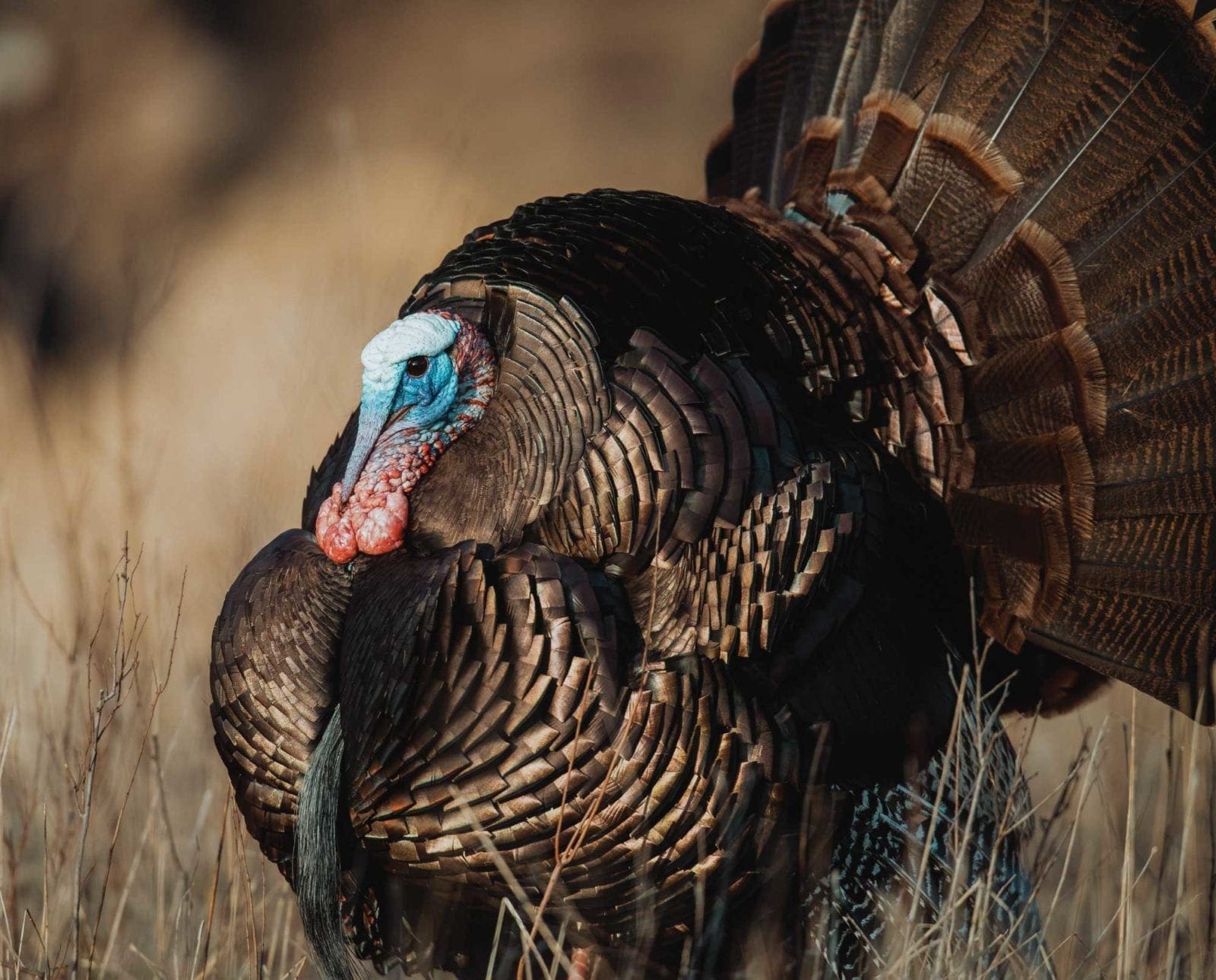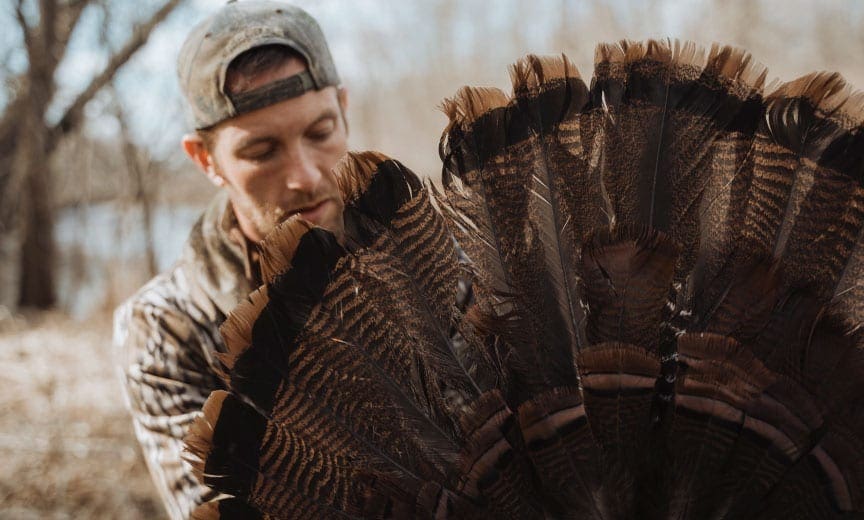Home » Turkey Hunting » Eastern Wild Turkey (Meleagris gallopavo silvestris) – A Wild Turkey Profile
Eastern Wild Turkey (Meleagris gallopavo silvestris) – A Wild Turkey Profile

A.J. DeRosa founded Project Upland in 2014 as an excuse…
Rebounding from near extinction, the Eastern Wild Turkey is the King of Game Birds
The wild turkey is one of our country’s greatest conservation success stories. Coming back from the brink of extinction, they have expanded their range and become a more common sight every year in unlikely places. But of the several turkey subspecies in our nation, the Eastern wild turkey (Meleagris gallopavo silvestris) is undoubtedly the most prolific and most recognizable.
Description and life history of the Eastern wild turkey
The Eastern wild turkey subspecies is probably the most iconic symbol of the turkey for many people. It is a large bird with long legs, a long neck, and dark feathers. Males typically weigh much more than females, with males weighing 18 to 30 pounds and females weighing 8 to 12 on average (NWTF 2018). Males are also showier in appearance than females. Male feathers have an iridescent gold and green sheen that reflects the sunlight, while females have a rather drab feather finish, enabling them to hide well in the underbrush on a nest. The Eastern wild turkey has black- or brownish-colored breast and body feathers, though its wings are cream-colored with black/brown bars. Its tail is chestnut-colored with a dark chestnut band across the tip which helps differentiate the Easterns from other subspecies (NWTF 2018). Eastern gobblers also typically have the longest beards of all the subspecies (NWTF 2018). Male heads will usually be red colored throughout the year, but may also contain shades of blue and white during the breeding season. Females normally have bluish-gray heads with more feathers present than males. Though females may develop spurs, they are unlikely to grow much, while male spurs will extend a few inches as they mature.
The breeding season generally runs from March to June, depending on which part of the country in which the turkeys are found (i.e., later in the North, earlier in the South). Males will start to court hens by strutting with their feathers fluffed out and tail fans displayed. They will also aggressively gobble back to a hen’s calls in the spring; Easterns are commonly held to be the loudest gobblers (NWTF 2018). A female chooses a mate by lying down on the ground in front of a male. Normally, 10 to 12 yellowish-tan eggs are laid in an approximately 10-inch by 10-inch nest scratched into the ground (Cornell 2018; NatureServe 2018). After 27 to 28 days of incubation, tan and brown-striped chicks follow their mother until they learn how to feed themselves in a matter of days (NatureServe 2018).
Poults feed heavily on invertebrates (e.g., insects and spiders) during this first summer as they are rich in protein. They transition to their adult diet of grasses, buds, grains, fruits, seeds, and hard mast as the summer turns into fall. Some adults may even eat amphibians and small reptiles opportunistically.
Turkeys are diurnal, which means they are active during the day. At night, they usually fly up into open-limbed mature trees to roost for the night, which keeps them safe from ground predators. In the early morning, they will fly down from their roosts and spend the day foraging on the ground in forest clearings and roadsides, rarely flying unless flushed at close quarters.
Range and habitat of the Eastern wild turkey
The Eastern wild turkey has the largest range of all the turkey subspecies, occurring in 38 states (NWTF 2018). Its primary range extends east of the Mississippi River, but it has stretched its borders west of this line, as well. Though turkeys are not particularly well suited for winters with deep snow, the Eastern wild turkey has steadily pushed its range into northern forests of the Upper Midwest and New England over time. Lack of winter habitat (i.e., cover) and food is still a limiting factor in these areas. It also occupies swamps and wet forests of the Southern states quite well, making them a very adaptable bird.
Generally, turkeys require a mix of habitat types to thrive. Mature woodlands (deciduous and/or coniferous) are required for roosting. In the fall, mature oak and hickory forests also provide hard mast, an important food source. Nesting cover includes field edges, upland shrubs, and pockets of open woodlands. Poults require “bugging habitat,” which are areas that support a healthy insect population and can include agricultural fields/hayfields, recent clearcuts and meadows. Early successional forest (i.e., young forest) is important to many species, such as ruffed grouse. This type of forest is often very diverse with sun-loving forbs, raspberries/blackberries, and buds, which are important food sources for adults.
Conservation issues of the Eastern wild turkey
As mentioned, turkey populations experienced a dramatic decline in the 19th and 20th centuries from extensive habitat loss and hunting pressure (Cornell 2018). But from a population low in the tens or hundreds of thousands, the wild turkey population started increasing again after conservation organizations like National Wild Turkey Federation started advocating for turkey habitat. Coupled with successful relocation and reintroduction efforts, the wild turkey rebounded and now enjoys a very stable existence in our country, particularly the Eastern subspecies. They have adapted to new habitats (e.g., cities and suburbs and northern forests) over time, which has helped them expand their range and persist.
Read: West Nile Virus Impact on Wild Turkeys

Hunting opportunities for the Eastern wild turkey
Because the Eastern wild turkey is the most abundant and far-spread of the turkey subspecies, you likely won’t have to travel far to hunt one unless you live in the Western states. Many Eastern turkey hunting states offer a spring and fall season for them, as well. Regulations vary widely across this range as to how many turkeys can be taken, which sex is legal to take, and daily bag limits versus season limits. Study them ahead of time to avoid confusion.
One of the most common spring turkey hunting tactics for Easterns is to find a roost location the night before a hunt. Early the next morning, set up along a feeding area field edge or along a likely travel route. Couple a hen decoy with a jake decoy and give hen calls to attract toms looking for love. When a tom sees a jake with a receptive hen, they may come into range easily or hang up frustratingly out of range. It just depends on the turkey and the situation. In most states, you can take one tom in the spring season.
In fall, it’s a different story. Toms and jakes tend to group together while hens separately group together. Set up within a feeding area and use tom or hen calls (you can often take a hen in the fall). It may even pay off to just sit silently in a high potential area, much like deer hunting. Turkey hunting requires a lot of patience, but it is very rewarding.
Sources:
Natureserve. 2018. NatureServe Explorer: An online encyclopedia of life. Accessed at: http://explorer.natureserve.org
Cornell (The Cornell Lab of Ornithology). 2018. All About Birds. Accessed at: https://www.allaboutbirds.org/guide/Wild_Turkey/id
NWTF (National Wild Turkey Federation). 2018. Learn About the Wild Turkey Subspecies. Accessed at: http://www.nwtf.org/hunt/article/wild-turkey-subspecies
A.J. DeRosa founded Project Upland in 2014 as an excuse to go hunting more often (and it worked). A New England native, he grew up hunting and has spent over 35 years in pursuit of big and small game species across three continents. He has a passion for side-by-side shotguns, inspiring him to travel the world to meet the people and places from which they come. Looking to turn his passion into inspiration for others, AJ was first published in 2004 and went on to write his first book The Urban Deer Complex in 2014. He soon discovered a love for filmmaking, particularly the challenge of capturing ruffed grouse with a camera, which led to the award-winning Project Upland film series. AJ's love for all things wild has caused him to advocate on the federal and state levels to promote and expand conservation policy, habitat funding, and upland game bird awareness. He currently serves as the Strafford County New Hampshire Fish & Game Commissioner in order to give back to his community and to further the mission of the agency. When those hunting excuses are in play, you can find him wandering behind his Wirehaired Pointing Griffon in the mountains of New England and anywhere else the birds take them.




